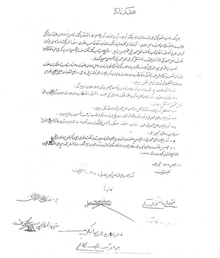Declaration of Independence (Azerbaijan)
| Declaration of Independence of Azerbaijan | |
|---|---|
 Original text of the Declaration in Azerbaijani | |
| Created | 28 May 1918 |
| Location | National Museum of History of Azerbaijan |
| Signatories | Hasan bey Aghayev, Fatali Khan Khoyski, Nasib Yusifbeyli, Jamo bey Hajinski, Shafi bey Rustambeyli, Nariman bey Narimanbeyov, Javad Malik-Yeganov and Mustafa Mahmudov |
| Purpose | To announce the independence of Azerbaijan |
The Declaration of Independence of Azerbaijan (Azerbaijani: Azərbaycanın İstiqlal Bəyannaməsi) is the declaration of independence of the Azerbaijan Democratic Republic from the Russian Empire. Azerbaijan was proclaimed independent in Tiflis on 28 May 1918.[1]
The Azerbaijan Democratic Republic was founded by the Azerbaijani National Council in Tiflis on May 28, 1918 after the collapse of the Russian Empire that began with the Russian Revolution of 1917. The Muslim representation in the defunct Transcaucasian Seim had constituted itself into the Azerbaijani National Council, and on May 28, 1918 proclaimed that a new nation was born. So far only a geographical reference, Azerbaijan now became the name of a state, and some 2 million people, called variously Tatars, Transcaucasian Muslims and Caucasian Turks, officially became Azerbaijanis.[2]
Adoption
On 28 May 1918 in the palace of the former governor of the Russian emperor in the Caucasus in Tiflis, in the blue saloon for Muslim group of Transcaucasian Seim members of Azerbaijan National Council gathered at the meeting chaired by Dr. Hasan bey Aghayev.[1] Dr. Hasan bey Aghayev informed the participants about the collapse of the Transcaucasian Sejm, as well as prevailing in the region internal and external situation.[1] Aghayev put the consideration of the free and independent Azerbaijan. After a long and thorough discussion, the Secretary Mustafa Mahmudov read the names of voters; 24 votes, with 2 abstentions, adopted a Declaration of Independence of Azerbaijan.[1] The Declaration was signed by Hasan bey Aghayev, Fatali Khan Khoyski, Nasib Yusifbeyli, Jamo bey Hajinski, Shafi bey Rustambeyli, Nariman bey Narimanbeyov, Javad Malik-Yeganov and Mustafa Mahmudov. Only Jafar Ahundov and one of the leaders of the party "Ittihad" Majid Sultan Ghani Zadeh didn't vote for the adoption of the Declaration.[3]
Annotated text of the Declaration
1. Azerbaijan is a fully sovereign state; it consists of the southern and eastern parts of Transcaucasia under the authority of the Azerbaijani people.
2. It is resolved that the form of government of the independent Azerbaijani state is a democratic republic.
3. The Azerbaijani Democratic Republic is determined to establish friendly relations with all, especially with the neighboring nations and states.
4. The Azerbaijani Democratic Republic guarantees to all its citizens within its borders full civil and political rights, regardless of ethnic origin, religion, class, profession, or sex.
5. The Azerbaijani Democratic Republic encourages the free development of all nationalities inhabiting its territory.
6. Until the Azerbaijani Constituent Assembly is convened, the supreme authority over Azerbaijan is vested in a universally elected National Council and the provisional government responsible to this Council.[2]
References
- 1 2 3 4 Азербайджанская Демократическая Республика (1918 - 1920). Элм. 1998. p. 316. ISBN 5-8066-0897-2.
- 1 2 Tadeusz Swietochowski. Russia and Azerbaijan: A Borderland in Transition. New York: Columbia University Press, 1995. ISBN 0231070683, p. 129
- ↑ Oğuztoğrul Tahirli. Zaqafqaziya Seyminin üzvü Cəfər Axundov. (Azerbaijani) // 525-ci qəzet. — 17 December 2011. — P. 28.
| Wikimedia Commons has media related to Declaration of Independence (Azerbaijan). |